Harish Viswanathan
Beamforming with hybrid reconfigurable parasitic antenna arrays
Feb 25, 2025Abstract:A parasitic reconfigurable antenna array is a low-power approach for beamforming using passive tunable elements. Prior work on reconfigurable antennas in communication theory is based on ideal radiation pattern abstractions. It does not address the problem of physical realizability. Beamforming with parasitic elements is inherently difficult because mutual coupling creates non-linearity in the beamforming gain objective. We develop a multi-port circuit-theoretic model of the hybrid array with parasitic elements and antennas with active RF chain validated through electromagnetic simulations with a dipole array. We then derive the beamforming weight of the parasitic element using the theoretical beam pattern expression for the case of a single active antenna and multiple parasitic elements. We show that the parasitic beamforming is challenging because the weights are subject to coupled magnitude and phase constraints. We simplify the beamforming optimization problem using a shift-of-origin transformation to the typical unit-modulus beamforming weight. With this transformation, we derive a closed-form solution for the reconfigurable parasitic reactance. We generalize this solution to the multi-active multi-parasitic hybrid array operating in a multi-path channel. Our proposed hybrid architecture with parasitic elements outperforms conventional architectures in terms of energy efficiency.
Multi-level Reliability Interface for Semantic Communications over Wireless Networks
Jul 07, 2024Abstract:Semantic communication, when examined through the lens of joint source-channel coding (JSCC), maps source messages directly into channel input symbols, where the measure of success is defined by end-to-end distortion rather than traditional metrics such as block error rate. Previous studies have shown significant improvements achieved through deep learning (DL)-driven JSCC compared to traditional separate source and channel coding. However, JSCC is impractical in existing communication networks, where application and network providers are typically different entities connected over general-purpose TCP/IP links. In this paper, we propose designing the source and channel mappings separately and sequentially via a novel multi-level reliability interface. This conceptual interface enables semi-JSCC at both the learned source and channel mappers and achieves many of the gains observed in existing DL-based JSCC work (which would require a fully joint design between the application and the network), such as lower end-to-end distortion and graceful degradation of distortion with channel quality. We believe this work represents an important step towards realizing semantic communications in wireless networks.
Downlink Power Control based UE-Sided Initial Access for Tactical 5G NR
May 22, 2024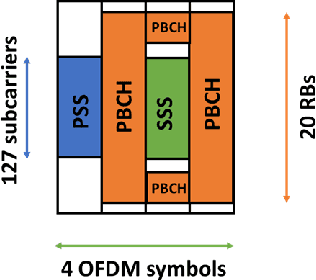
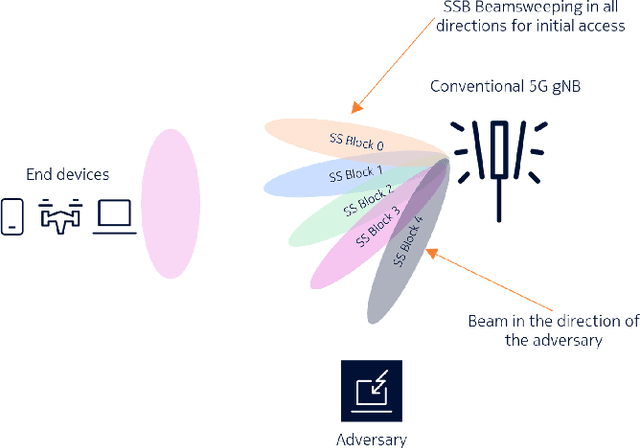
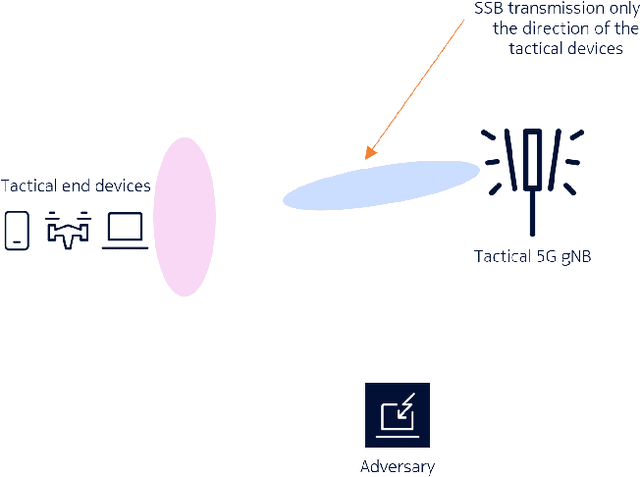
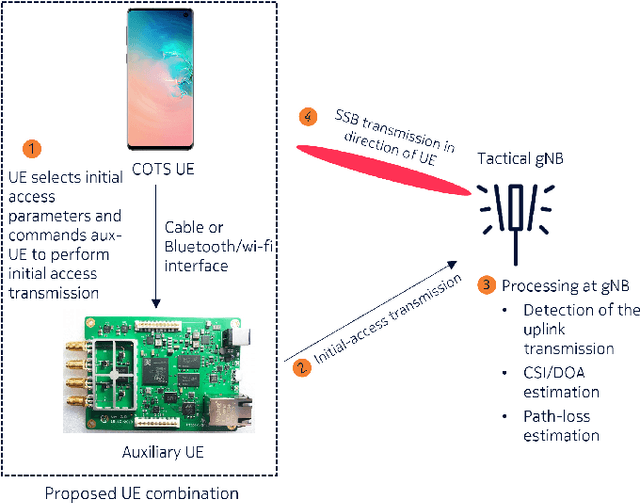
Abstract:Communication technologies play a crucial role in battlefields. They are an inalienable part of any tactical response, whether at the battlefront or inland. Such scenarios require that the communication technologies be versatile, scalable, cost-effective, and stealthy. While multiple studies and past products have tried to address these requirements, none of them have been able to solve all the four challenges simultaneously. Hence, in this paper, we propose a tactical solution that is based on the versatile, scalable, and cost effective 5G NR system. Our focus is on the initial-access phase which is subject to a high probability of detection by an eavesdropper. To address this issue, we propose some modifications to how the UE performs initial access that lower the probability of detection while not affecting standards compliance and not requiring any modifications to the user equipment (UE) chipset implementation. Further, we demonstrate that with a simple downlink power control algorithm, we reduce the probability of detection at an eavesdropper. The result is a 5G NR based initial-access method that improves stealthiness when compared with a vanilla 5G NR implementation.
Demystifying 5G NR Downlink Synchronization for Tactical Networks
May 21, 2024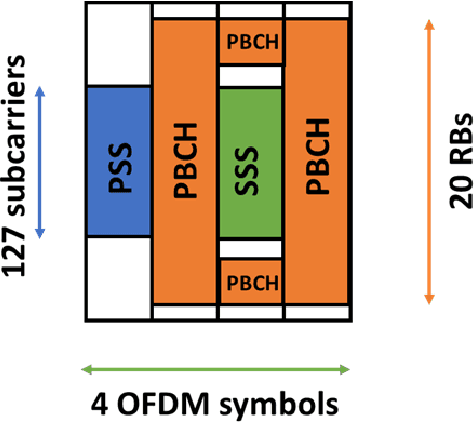
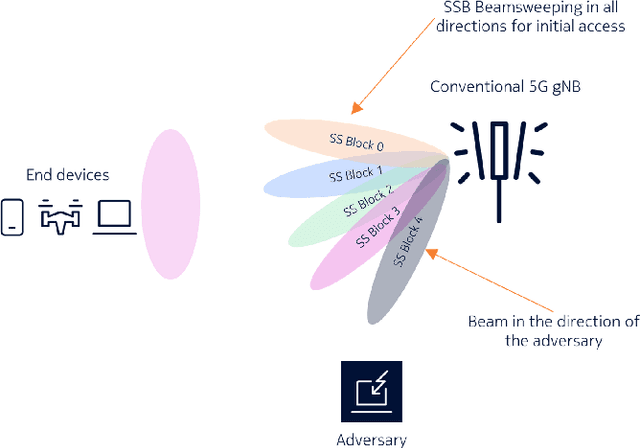
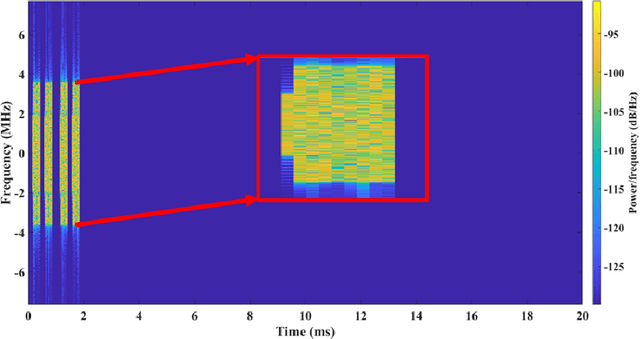
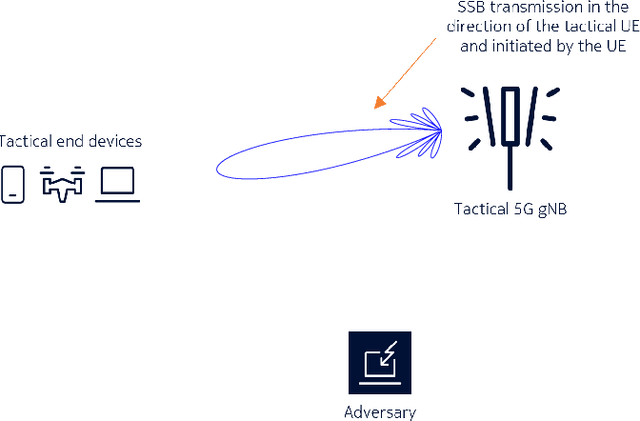
Abstract:5G NR is touted to be an attractive candidate for tactical networks owing to its versatility, scalability, and low cost. However, tactical networks need to be stealthy, where an adversary is not able to detect or intercept the tactical communication. In this paper, we investigate the stealthiness of 5G NR by looking at the probability with which an adversary that monitors the downlink synchronization signals can detect the presence of the network. We simulate a single-cell single-eavesdropper scenario and evaluate the probability with which the eavesdropper can detect the synchronization signal block when using either a correlator or an energy detector. We show that this probability is close to $ 100 $% suggesting that 5G out-of-the-box is not suitable for a tactical network. We then propose methods that lower this value without affecting the performance of a legitimate tactical UE.
A generalization of the achievable rate of a MISO system using Bode-Fano wideband matching theory
Oct 15, 2023

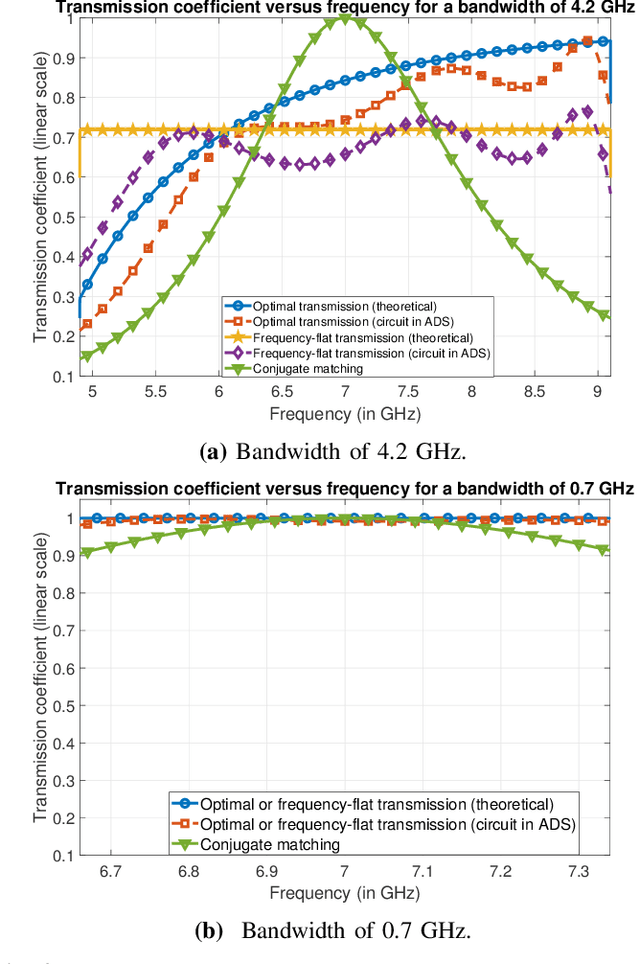
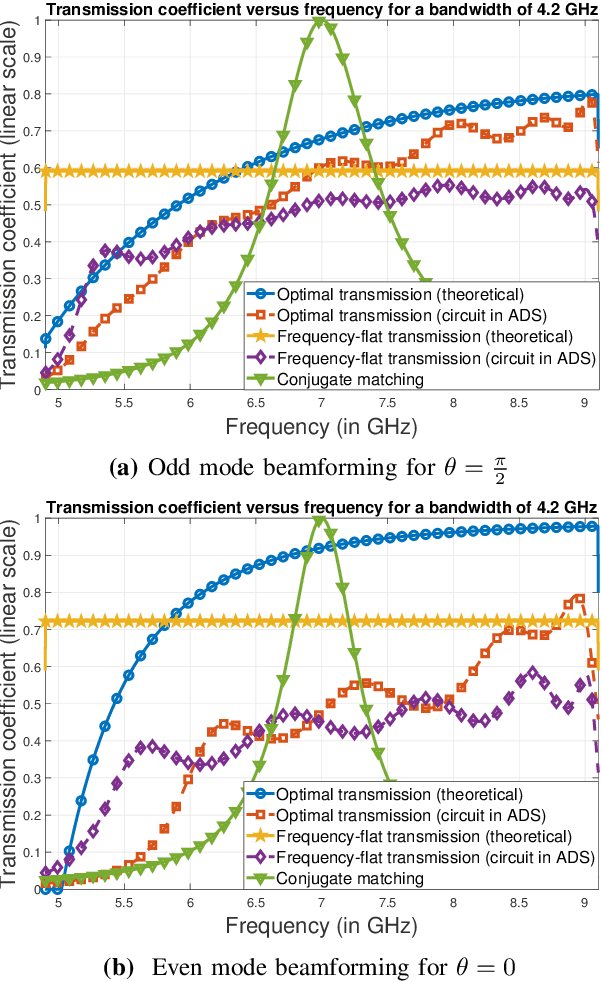
Abstract:Impedance-matching networks affect power transfer from the radio frequency (RF) chains to the antennas. Their design impacts the signal to noise ratio (SNR) and the achievable rate. In this paper, we maximize the information-theoretic achievable rate of a multiple-input-single-output (MISO) system with wideband matching constraints. Using a multiport circuit theory approach with frequency-selective scattering parameters, we propose a general framework for optimizing the MISO achievable rate that incorporates Bode-Fano wideband matching theory. We express the solution to the achievable rate optimization problem in terms of the optimized transmission coefficient and the Lagrangian parameters corresponding to the Bode-Fano inequality constraints. We apply this framework to a single electric Chu's antenna and an array of two electric Chu's antennas. We compare the optimized achievable rate obtained numerically with other benchmarks like the ideal achievable rate computed by disregarding matching constraints and the achievable rate obtained by using sub-optimal matching strategies like conjugate matching and frequency-flat transmission. We also propose a practical methodology to approximate the achievable rate bound by using the optimal transmission coefficient to derive a physically realizable matching network through the ADS software.
Precoding-oriented Massive MIMO CSI Feedback Design
Feb 22, 2023

Abstract:Downlink massive multiple-input multiple-output (MIMO) precoding algorithms in frequency division duplexing (FDD) systems rely on accurate channel state information (CSI) feedback from users. In this paper, we analyze the tradeoff between the CSI feedback overhead and the performance achieved by the users in systems in terms of achievable rate. The final goal of the proposed system is to determine the beamforming information (i.e., precoding) from channel realizations. We employ a deep learning-based approach to design the end-to-end precoding-oriented feedback architecture, that includes learned pilots, users' compressors, and base station processing. We propose a loss function that maximizes the sum of achievable rates with minimal feedback overhead. Simulation results show that our approach outperforms previous precoding-oriented methods, and provides more efficient solutions with respect to conventional methods that separate the CSI compression blocks from the precoding processing.
Energy Efficient Design of Extreme Massive MIMO
Jan 13, 2023



Abstract:Ever since the invention of Bell Laboratories Layer Space-Time (BLAST) in mid 1990s, the focus of MIMO research and development has been largely on pushing the limit of spectral efficiency. While massive MIMO technologies laid the foundation of high throughput in 5G and beyond, energy efficiency of the associated radio system leaves much room for improvement. With the substantial negative implications of climate change looming ever closer, enabling sustainability is of paramount importance for any future technology, and minimizing energy use is a key dimension of achieving sustainability. Thus, every aspect of 6G design, implementation, and operation will be scrutinized to maximize energy efficiency. An analysis of the massive MIMO 5G radio energy consumption at different loads reveals under what specific conditions 6G should outperform 5G, setting qualitative energy efficiency design goals for 6G. Following this, we propose some design principles for the 6G, focusing on novel operational, component technology, and architecture innovations to minimize energy consumption.
A wideband generalization of the near-field region for extremely large phased-arrays
Jun 30, 2022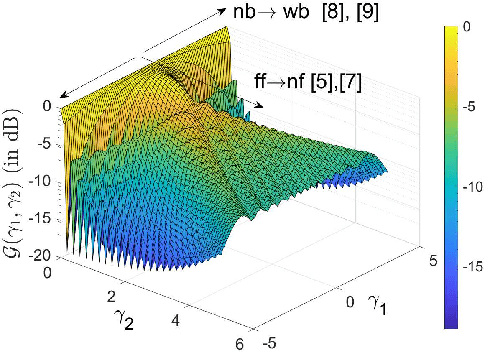
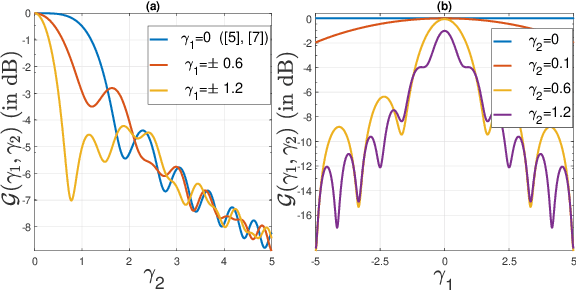
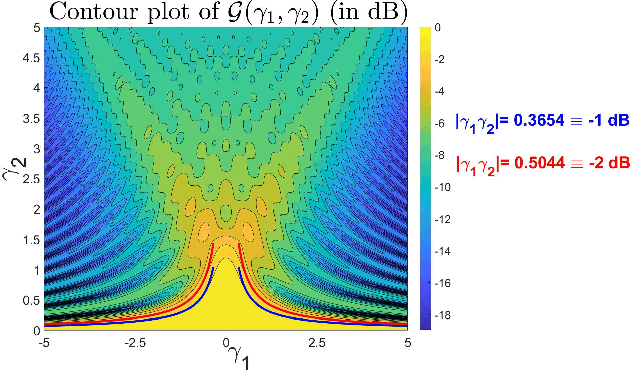
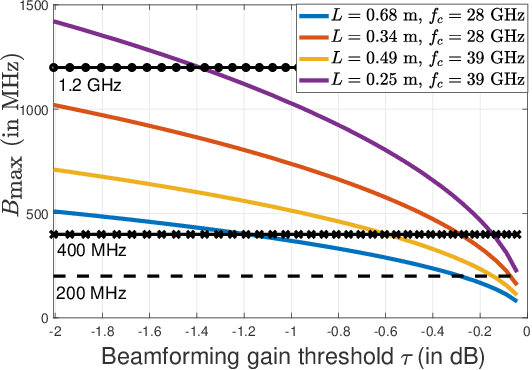
Abstract:The narrowband and far-field assumption in conventional wireless system design leads to a mismatch with the optimal beamforming required for wideband and near-field systems. This discrepancy is exacerbated for larger apertures and bandwidths. To characterize the behavior of near-field and wideband systems, we derive the beamforming gain expression achieved by a frequency-flat phased array designed for plane-wave propagation. To determine the far-field to near-field boundary for a wideband system, we propose a frequency-selective distance metric. The proposed far-field threshold increases for frequencies away from the center frequency. The analysis results in a fundamental upper bound on the product of the array aperture and the system bandwidth. We present numerical results to illustrate how the gain threshold affects the maximum usable bandwidth for the n260 and n261 5G NR bands.
Towards a 6G AI-Native Air Interface
Dec 15, 2020



Abstract:Each generation of cellular communication systems is marked by a defining disruptive technology of its time, such as orthogonal frequency division multiplexing (OFDM) for 4G or Massive multiple-input multiple-output (MIMO) for 5G. Since artificial intelligence (AI) is the defining technology of our time, it is natural to ask what role it could play for 6G. While it is clear that 6G must cater to the needs of large distributed learning systems, it is less certain if AI will play a defining role in the design of 6G itself. The goal of this article is to paint a vision of a new air interface which is partially designed by AI to enable optimized communication schemes for any hardware, radio environment, and application.
 Add to Chrome
Add to Chrome Add to Firefox
Add to Firefox Add to Edge
Add to Edge